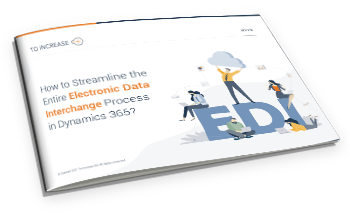Have you had issues working with integration platforms that had problems getting data in and out of the ERP system? If so, you understand the challenges of working with a solution that is not flexible or easily integrated with Microsoft Dynamics 365.
A lot of our prospects ask us “how does your EDI (electronic data interchange) solution or application integration platform integrate with Microsoft Dynamics 365?” In this blog, we will address this question. This blog will help you understand the advantages of investing in a solution that not just seamlessly integrates with the ERP but is embedded in Dynamics 365. We also explain how EDI Studio has several benefits in comparison to other solutions that are not built inside the Dynamic 365 environment.
What offerings are available under To-Increase’s Business Integrations Solutions domain?
To-Increase offers solutions for EDI communication – EDI Studio, application integration and data migration – Connectivity Studio, and solutions to manage data governance. For data governance, we offer a solution for master data management – MDM Studio and a solution to manage data quality – Data Quality Studio. Connectivity Studio is a standalone solution and EDI Studio, or MDM Studio are bundled with Connectivity Studio. Some of our customers opt for the BIS suite which is a combination of all three solutions. In this blog, however, we will be focusing only on EDI Studio and Connectivity Studio.
EDI Studio and Connectivity Studio are embedded within Dynamics 365
Our solutions are not just easy to integrate with Dynamics 365, they are in fact embedded inside Dynamics 365. This means that you could use all the features of Dynamics 365 and use our EDI solution when a document comes in without logging out of your ERP. Connectivity Studio helps in pulling that data in and out of the system. This also makes managing exceptions and errors in EDI communication a breeze.
Since it is an embedded experience with EDI Studio, users won’t experience a major business change in managing tasks on the ERP, and when an EDI notification comes in, they can easily switch to EDI. The processes will remain the same for the end-user with a quick learning curve.
If your IT team has the experience of integrating and working with other systems and your ERP platform in the past, they would agree with us on the fact that, if the solution is embedded, it also makes it easier to manage in the long run and will need lesser maintenance. That is another advantage of our solutions being built inside Dynamics 365.
|
Related reading: To understand the advantages of using an embedded solution, read our blog. |
Also, do watch the demo video below that captures the ease of EDI messaging using an embedded solution.
How are our business integration solutions built?
To understand how well our solutions are integrated with Microsoft Dynamics 365 ERP, it is important to understand the internal workings of our EDI and integration solutions.
Since we are an embedded solution, we use the same code as Microsoft Dynamics 365. In other words, we use the same development language. And we use the same business logic as Microsoft does, which works to an advantage for our customers.
Let’s look at an example to explain this. Say you need to create an integration to import a sales order. When the customer for the order and the product lines are selected, all the business logic will be executed automatically. The business logic will validate the data and add the customer and product details (delivery address, price, etc.). This makes the information more accurate, and the process more convenient.
That is an upside of our solution being embedded inside Dynamics 365. This way we make use of functionality that already exists inside the ERP, therefore, not only do our solutions add value but also help you optimize the potential of your ERP solution.
What are the limitations of data transfer through the Dynamics 365 database?
Dynamics 365 has a database where all the data is stored and there are tools in between that aid the data transfer. The Data Management Framework (DMF) offers the functionality to validate the data coming in and carry out the mapping between the file and the database. When we import or export some data, that information is stored in a database.
In the database, you have tables for customer information, products, vendors, and so on. However, it is not easy to get data out of all the tables in Dynamics 365. Microsoft delivers about 1500 data entities that help in getting the data in and out of the database, in a library. So, you need to find the right data entity that is a fit for your organization’s needs. Entities contain a set of tables, such as customer, product data, etc., and could have different versions per data topic (for example Customers, Customers V2, etc.).
How do our solutions resolve the inflexibility of Dynamics 365’s data entities?
In Dynamics 365, there are currently about 12,000 tables and 1500 data entities. The table count could be even more when you install ISV products or start your own development. When you start an integration project with another system, a complication could arise when you have that information in Dynamics 365 but the data entity does not exist. Then customer entities need to be developed to be able to get the data out of Dynamics 365 and the Data Management Framework.
Another scenario you could have experienced is that you worked with another EDI solution and had trouble with tables, fields, or customization. That was probably because the solution uses Microsoft’s existing data entities. If you want to add fields or tables that are not present in the data entities, then getting that data in and out of the system will be a challenge. Microsoft’s data entities have a fixed number of tables and fields. If you want to add extra tables or fields, you need to start development and will need a special resource which might not be possible for every organization. The restriction to store the information in the same data entity is the challenge we help mitigate with our EDI solution.
Connectivity Studio is built inside Dynamics 365, but does not use the Data Management Framework. It could use the data entities but has a more flexible approach as you can use the tables relevant for your organization or company without having to browse through the thousands of data entities available. The solution uses tables and views to import and export data. You could install an ISV solution or perform customizations to add extra tables/fields. These are immediately available in Connectivity Studio for configuring during an integration. Connectivity studio is even flexible enough to use a mix of tables, views, and entities for the same integration.
What are the benefits of software built within the Microsoft Dynamics 365 environment?
Besides offering an embedded experience, and a very familiar user interface, EDI Studio, and Connectivity Studio offer several advantages cause of how well integrated they are with Dynamics 365.
1. Add triggers for streamlined data and communications
Once you have integrated your business systems using Connectivity Studio to your ERP, when you do make a change in Dynamics 365 for example, a trigger is created when a customer record is updated. This will initiate an interface to update the CRM system as well.
Since Connectivity Studio seamlessly transfers data in and out of your systems into the ERP, your data will always be synchronized. You can also add triggers for certain processes which can help you streamline communications between business systems. For example, if you want to create an alert when you finish a production order so that the corresponding document can be sent to your customer you can add a trigger for that.
2. Updates with the Microsoft upgrades
If Microsoft adds or updates a functionality, then there is no need for development. As our solution offers you the flexibility to use (custom) tables, or a combination of multiple standard tables for integrations so even with the new upgrades to data entities, your solution will work just fine.
3. History management
We capture all import and export data in a history log. Since it is inside Dynamics 365, if something goes wrong, you can validate it in history with the information inside Microsoft Dynamics 365. Any error of an interface can send an e-mail, alert or start a business event. For example, if you perform an import of your new trade agreement and the system shows an error, you could use a business event to activate Microsoft’s Power Automate tool.
4. Staging area
We have a staging area in our solution, for data coming in. You can make corrections or validate information against the date received in Dynamics 365, before transferring it to the EDI solution. So, for example, the salesperson or business user can check the order with the error, and can choose to make a correction or a rejection without disrupting the flow of business.
5. Configuration based – no need for development
Our solutions, EDI Studio and Connectivity Studio help us extract data from any table in Dynamics 365 without the need for any development. When you start development, in case you are using another business system, then the challenge arises when it is time for maintenance, you need a dedicated resource. Our solution is configuration-based, so you need to select the tables and fields and you’re done. You will need to continue a little bit of maintenance work post that but all you need to do is configure data in the system which is a lot easier than coding!
Harness the power of your ERP with an embedded solution
Embedded solutions that are built within the ERP to handle EDI, migrations and integrations, have even more advantages than standalone EDI or integration solutions. We hope our blog has helped explain how the integration of our EDI and application integration solutions with Microsoft Dynamics 365 will not be a cause of concern for your IT team.
If you currently use Microsoft Dynamics 365 or are considering migrating to the ERP, download our e-book from the link at the bottom of the blog to understand how you can streamline your EDI communications within Dynamics 365.
Interested in Connectivity Studio and EDI Studio?
If you are interested in our solutions, you could:
- Read our honest reviews of EDI Studio and Connectivity Studio for Dynamics 365
- Download our factsheets for EDI Studio and Connectivity Studio for Dynamics 365
- Schedule some time with our BIS experts





